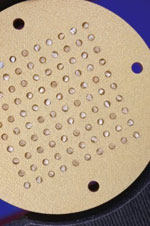Optical dating of Quaternary Glaciation in Southern Chile using Single Grains of Quartz

 Luminescence dating of sediments relies upon exposure of mineral grains to sufficient sunlight at deposition to remove any charge that may remain from previous irradiation over geological time. One of the major advantages of optically stimulated luminescence (OSL) methods over methods developed in the 1980's based on thermoluminescence (TL) is that the OSL signal is reset by exposure to daylight several orders of magnitude more rapidly. However, in many depositional environments even the OSL signal may not be completely reset at deposition. In the last decade ALRL has pioneered the measurement of single mineral grains as a method for identifying those grains which were reset, providing methods for dating such complex sediments.
Luminescence dating of sediments relies upon exposure of mineral grains to sufficient sunlight at deposition to remove any charge that may remain from previous irradiation over geological time. One of the major advantages of optically stimulated luminescence (OSL) methods over methods developed in the 1980's based on thermoluminescence (TL) is that the OSL signal is reset by exposure to daylight several orders of magnitude more rapidly. However, in many depositional environments even the OSL signal may not be completely reset at deposition. In the last decade ALRL has pioneered the measurement of single mineral grains as a method for identifying those grains which were reset, providing methods for dating such complex sediments.
An NERC project with Neil Glasser (Aberystwyth), Stephan Harrison (Exeter) and Duller has used such single grain measurements to date glacigenic sediments from the margins of the Northern Patagonian Ice Sheet, Chile (Duller 20061; Glasser et al, 20062; Harrison et al. 20083). These sediments are extremely challenging for OSL dating. Only between 1-2% of the grains yield any luminescence signal, and of these grains only a small proportion have been reset at deposition. However, by undertaking large numbers of measurements using the single grain OSL system developed by ALRL staff in collaboration with colleagues in Denmark, it has been possible to date such sediments. At a number of sites in Chile it has been possible to confirm the validity of these OSL ages by comparison with cosmogenic radionuclide measurements on boulders associated with moraines. Together, the OSL and cosmogenic ages have enabled a detailed record of glacier fluctuations in this key area through the Holocene. A review paper by Duller (2008)4 used some of the work from Chile as examples of the importance of single grain analysis in luminescence dating.
- 2006. Single grain optical dating of glacigenic deposits. Quaternary Geochronology, 1: 296-304.
- 2006. Evidence from the Rio Bayo valley on the extent of the North Patagonian Icefield during the Late Pleistocene-Holocene transition. Quaternary Research, 65: 70-77.
- 2008. Glaciar León, Chilean Patagonia: late-Holocene chronology and geomorphology. The Holocene, 18: 643-652.
- 2008. Single grain optical dating of Quaternary sediments: why aliquots size matters in luminescence dating. Boreas, 37: 589-612. DOI
